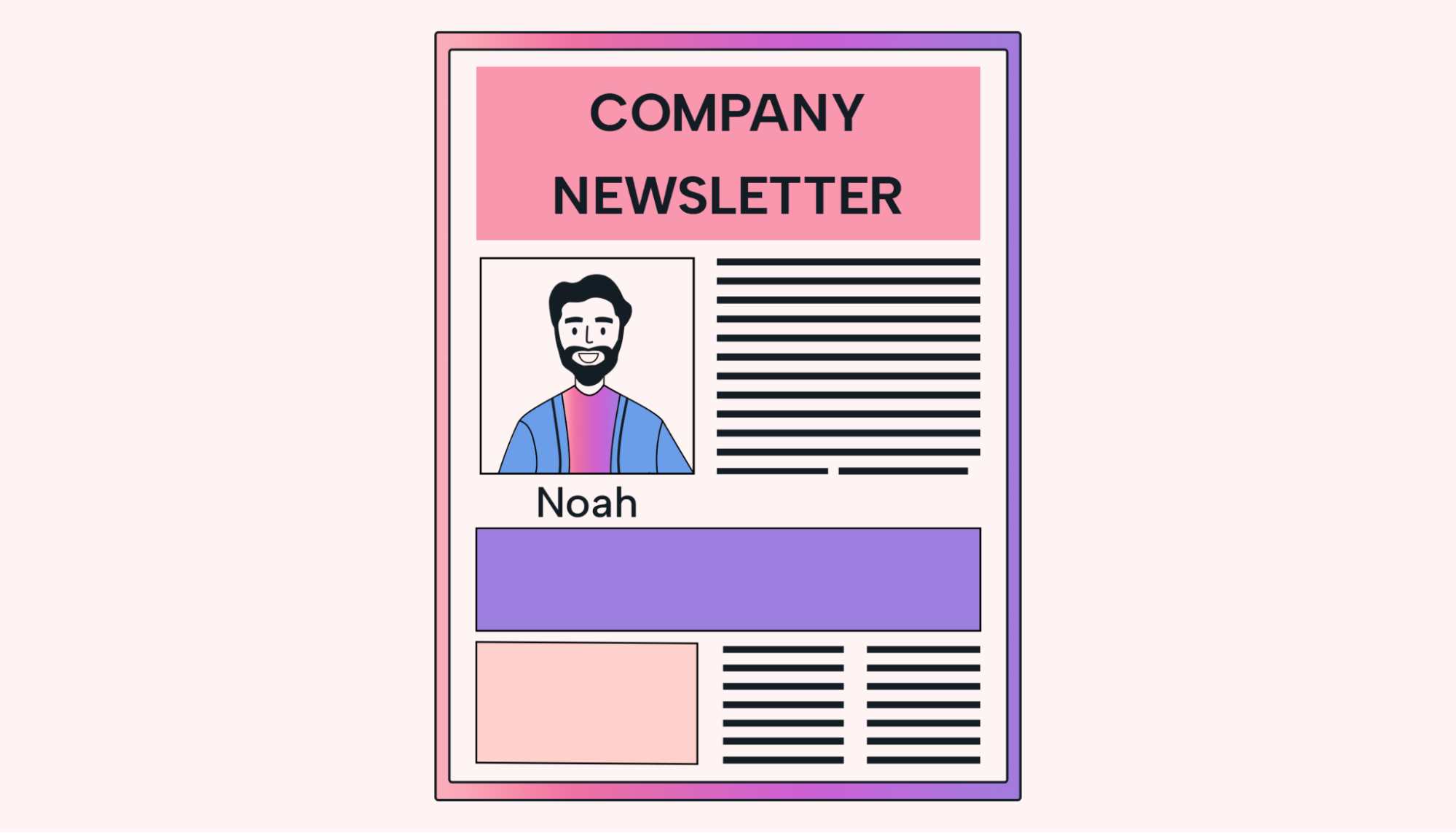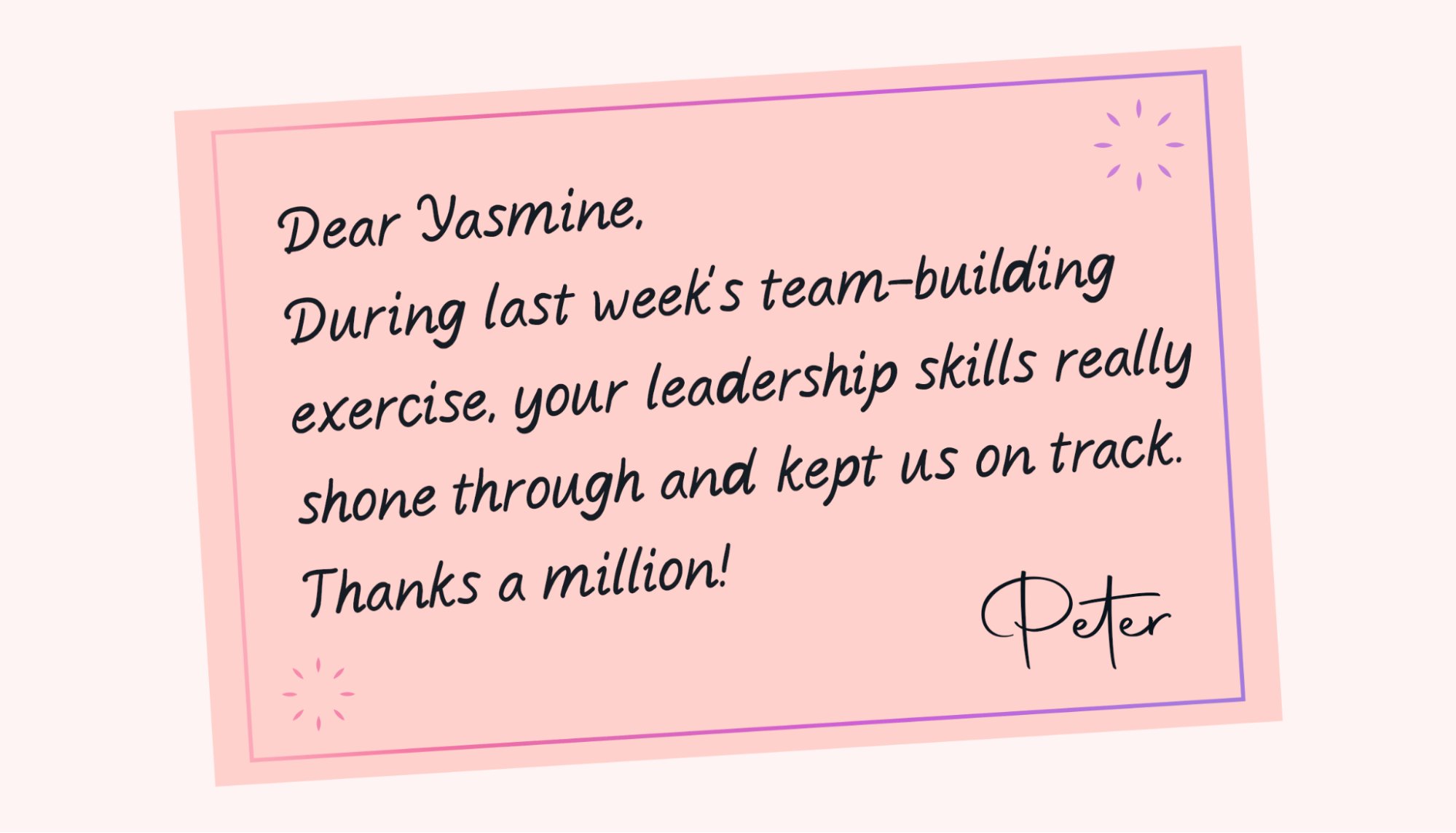Employees often feel like cogs in a vast corporate machine — unknown and unappreciated.
Fortunately, employee recognition can counteract this sense of alienation. A simple “thank you” for a job well done, for instance, can turn an ordinary day into a memorable one.
But what does it take to make sure our acts of recognition are both genuine and impactful?
Our 50+ no-fluff employee recognition examples, which range from verbal and written praise to tangible awards, will provide you with ideas and inspiration for creating a culture of recognition and making your employees feel truly appreciated.
Employee recognition: types and categories
Let’s do a quick inventory of the types and categories of recognition available to company leadership. We’ll also give a simple example for each of them.
Types of recognition
Gestures of recognition can be grouped into the following four types:
1. Verbal recognition
Spoken recognition can take the form of personalized commendations at meetings.
Example: “I’d like everyone to take a moment to recognize Jenna for her innovative approach in last week’s client presentation. It made a huge difference!”
You can also offer spontaneous praise during casual conversations.
Example: “Hey, Tom, I noticed the extra hours you put into the project. Your dedication hasn’t gone unnoticed. Thank you.”
2. Written recognition
Handwritten notes are a great way to show you appreciate the recipient’s efforts.
Example: A note left on an employee’s desk reading, “Sarah, your enthusiasm during the workshop was infectious. Thank you for lifting the team’s spirits!”
An alternative is a formal letter or email of appreciation.
Example: “Dear Miguel, Your contributions to the quarterly report were invaluable. We’re fortunate to have your analytical mind on our team.”
3. Gifts
When giving a gift, select a thoughtful item that reflects the recipient’s personal interests.
Example: Gifting a subscription to a photography magazine to Lisa, a passionate amateur photographer.
You could also give a generic but universally appreciated item.
Example: Presenting a Starbucks gift card with a note reading, “For all those coffee breaks you missed while going the extra mile to meet the project deadline!”
4. Awards
Give an employee a personal achievement trophy or plaque.
Example: Awarding an “Employee of the Month” plaque for an outstanding performance in sales.
Special mentions on company platforms or newsletters also make a point.
Example: Featuring an employee in the company newsletter under “Star Performers,” highlighting their achievements for the month.
 |
Recognition categories
Recognition can also be grouped into the following three categories to help leaders determine how to express it:
1. Formal/informal
Formal recognition usually takes the form of scheduled award ceremonies.
Example: Hosting a quarterly “Achievers Gala” where teams nominate their peers for various categories.
Impromptu, informal acknowledgments are also effective.
Example: Surprising Emily by announcing a recent work accomplishment during a routine team lunch.
2. Public/private
Public recognition takes place in front of the entire team or staff.
Example: Giving a round of applause for Raj during the team meeting for his recently acquired certification.
The alternative is to express discreet personal accolades.
Example: Pulling Jordan aside to personally thank him for handling a difficult task so gracefully.
3. Tangible/intangible
Physical gifts are tangible tokens of appreciation that will continue to remind employees of the praise they received.
Example: Gifting Elena a personalized pen set after her first year with the company.
Intangible expressions of recognition manifest as words of gratitude and encouragement. While they’re more fleeting than other recognition forms, they can be just as meaningful for the recipient.
Example: Telling Zoe, “Your project execution was flawless. We’d be two weeks behind if you hadn’t taken the lead.”
We’ll use these types and categories to delve more deeply into meaningful employee recognition examples that your workforce will respond to positively.
Verbal accolades: What do you say to recognize employees?
Let’s start with how to express verbal recognition.
Here are some tips for recognizing someone in person:
Be authentic in your praise
Employees can easily discern between empty words and genuine, deserved praise.
Authentic recognition has a lasting impact. It generates trust and strengthens employee-manager relationships.
An authentic expression of recognition is as follows: “Wow, Joan, this report is one of the best that has ever crossed my desk. You’ve saved me a lot of time by being so thorough. I really appreciate your innovative ideas.”
 |
Tailor employee recognition to individual achievements
It’s important to recognize specific achievements. For instance, instead of just saying, “Great work,” say, “Your insightful comments helped the team break out of the analysis paralysis we got stuck in. Thank you!”
Tailored recognition takes into account the employee’s role and responsibilities. For instance, you could say to a designer, “The graphics you created captured the brand essence brilliantly.”
Recognize achievements as soon as they occur to show that you’re observant and appreciative of real-time efforts. For instance, say, “I noticed the way you handled that difficult client call earlier this morning. Fantastic job!”
Avoid generic praise
Generic praise usually does more harm than good. Overused phrases, like “good job,” can lose their impact over time and sound hollow and meaningless.
Describe what specifically was done well. For a project lead, for instance, you might say, “The way you designed that process document was the key to making sure everything ran smoothly and efficiently.”
Add a personal touch by incorporating your personal knowledge of the employee. For instance, “I know how you love challenges, so it’s no surprise you excelled in this project. Well done!”
Written praise: How do you write an employee recognition message?
In this section, you’ll find tips and examples for how to help written tokens of appreciation stand out.
Personalize your message
Address your employees personally, and avoid generic openings. “Hey, Sam!” feels more personal than just “Hi.”
Also, mention specific achievements and highlight unique accomplishments. For instance, say, “Your report on market trends was both insightful and comprehensive. It paved the way for the breakthrough we had in our strategy session yesterday.”
In recognition, context matters. Describe the situation or event where the achievement took place. For instance, “During last week’s team-building exercise, your leadership skills shone through.”
 |
Reinforce company values
Highlight how the employee’s actions align with the company’s core values. “Your proactive approach in how you managed this project truly reflects our value of leading by example.”
Encourage employees to continue embodying these values. “We hope to see more of such powerful actions that resonate with our mission.”
There may also be occasions to recognize employees when they exemplify company values outside of typical tasks, such as in volunteering or mentoring. “Hey Sally, the way you reached out to that visitor who needed special assistance was a stellar demonstration of our company's value of putting our customers first.”
The power of handwritten notes
Emails are quick to write, but in a work environment dominated by digital messages, a handwritten note stands out and demonstrates genuine appreciation.
Employees can keep handwritten notes as lasting tokens of recognition. They can also refer to them for encouragement when they are facing challenges.
Got crummy handwriting? Even a typed and printed message with a personal note and signature at the bottom has a stronger impact than a text or email.
Sample templates
Here are some templates of written notes for different occasions:
Project completion: “Dear [Name], Your role in [specific project] was invaluable. Your expertise in [specific skill] propelled us to success. Thank you!”
Work anniversary: “Happy work anniversary, [Name]! Your contributions over the [X years/months] have been pivotal to our growth. Here’s to many more years of success!”
Handling difficult situations: “Hi [Name], I noticed how you managed the situation with [specific challenge]. Your calmness and problem-solving skills are commendable.”
Team collaboration: “[Name], the way you collaborated with the [specific department/team] led to high-quality work. Your ability to bridge ideas was a game-changer.”
Gifts: What are appropriate gifts, and when and how do you give them?
Gifts are an easy way to show employee appreciation — but only if they’re thoughtful and meaningful for the employee.
Below are some employee recognition ideas and examples of how to make your gifts truly valuable and memorable for those who receive them.
 |
Note: for all these gifts, consider adding a personal written or verbal note.
Personal interest gifts
Books: If you know an employee’s favorite author or book genre, a book can be a thoughtful gift. Example: Gifting Michelle Obama’s Becoming to someone who admires Michelle.
Hobby-related items: Acknowledging personal hobbies shows you care about the employee beyond their work. For a gardening enthusiast, a plant or special gardening tool can be the perfect gift.
Music and entertainment: Consider gifting a concert ticket or streaming service subscription if you know the recipient’s taste in music or movies.
Professional growth gifts
Courses: Offer to sponsor an online course that aligns with the employee’s role or aspirations. For a budding digital marketer, a course on SEO or content marketing can be a great option.
Workshops: Encourage continuous learning by enrolling them in relevant workshops. An example could be a writing workshop for a content creator.
Books and magazines: Industry-relevant books or magazine subscriptions can provide the employee with valuable insights and knowledge.
Lifestyle gifts
Spa vouchers: A relaxing day at the spa can be a great way to say “thank you” to an employee after a demanding project.
Gourmet baskets: Curated gourmet baskets with a selection of fine teas, chocolates, or cheeses can be a delightful reward for a job well done.
Experience gifts: Think outside the box with an experience like a hot air balloon ride, wine-tasting event, or pottery class.
The art of timely gifting
Some of the best gift-giving moments take place at the following times:
After a project’s completion: Celebrate a big win or the end of a challenging project with a gift that lets the employee relax and rejuvenate, such as a weekend getaway package or a dinner voucher at a fancy restaurant.
On a work anniversary: Recognize loyalty and dedication. For a five-year anniversary, consider a personalized gift, like an engraved pen or a watch.
On a birthday: A simple gesture, like a birthday cake or a personal gift, shows the employee they’re valued as an individual.
At an unexpected time: Sometimes, a surprise gift without a specific reason can have the biggest impact. It shows that you value the person consistently, not just at specific times.
 |
Tip: Note special dates for your team members (birthdays, anniversaries, individual accomplishments) in your online calendar so you never miss an important occasion.
Awards: What kinds of meaningful awards will employees enjoy?
Awards come in different shapes and sizes. Here are some examples of thoughtful rewards for your employees.
Traditional awards
Plaques: Customized plaques for achievements like “Employee of the Year” or “Top Sales Performer” can be proudly displayed on an office desk.
Trophies: Consider trophies for team competitions or milestones, as they can help create a sense of pride and accomplishment.
Certificates: A certificate recognizing specific accomplishments or skills, coupled with personal notes, can be a tangible reminder of an employee’s contributions.
Modern awards
Digital badges: In the age of gamification, digital badges for online platforms can be a contemporary way to recognize achievements, skills, or milestones.
Profile features on company sites: Featuring outstanding employees on the company’s website or intranet can provide a platform-wide acknowledgment and bolster their professional profiles.
Social media shoutouts: Recognize employees on company social media platforms to let the wider world know of their achievements.
Experience-oriented awards
A day off: Rewarding hard work with an extra day off can provide an employee with much-needed relaxation and show you value their work-life balance.
Team outings: Treat a stellar team to an outing like a movie night, a theme park visit, or a group dinner. This serves as both a reward and a team-building exercise.
Lunch with the CEO: A one-on-one lunch with the CEO or another top executive can be both an honor and an opportunity for the employee to share insights or aspirations.
 |
How to make sure awards are significant to the recipients
Here are some tips for helping to ensure that the recognition you give your employees is meaningful to them:
Ensure the award is relevant: Select an award that is relevant to the recipient’s role, achievements, and preferences.
Add a personal touch: Add a personal note or message that indicates you understand and value the employee’s specific contributions.
Avoid one-size-fits-all awards: While it might be easier to give the same award to everyone, tailored rewards help employees feel individually recognized and valued.
Collect feedback: Regularly gather feedback on award initiatives so the awards remain meaningful and evolve with employee preferences and industry trends.
Be ready for recognitions with Motion’s intelligent calendar
Given the broad spectrum of employee recognition methods available, there are many opportunities to reward outstanding achievements and special moments. And when done right, employee recognition programs have the power to boost employee morale and productivity.
Use the employee recognition examples in this article to help you select meaningful awards — and personalize them in ways that will make your employees feel valued.
And don’t forget to log these recognition events in your online calendar. With Motion, it’s easy to keep track of upcoming employee anniversaries, birthdays, and other events, so you can always recognize and honor your team members at the right times.





